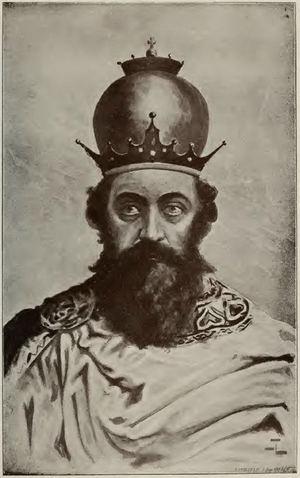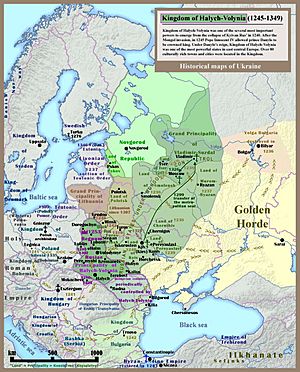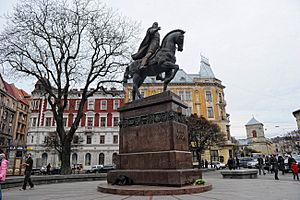Daniel of Galicia facts for kids
Quick facts for kids Daniel of Galicia |
|
|---|---|
| King of Ruthenia | |

Daniel of Galicia (early 20th century image)
|
|
| King of Galicia and Volhynia (King of Ruthenia) | |
| Reign | 1253–1264 |
| Predecessor | title created |
| Successor | Lev Danylovych |
| Born | 1201 Halych (now Ukraine) |
| Died | 1264 Kholm (modern Chełm, Poland) |
| Spouse | 1st. Anna Mstislavna of Novgorod (daughter of Mstislav Mstislavich the Bold), 2nd. NN (niece of King Mindaugas) |
| Issue | Irakli Danylovich Lev I of Galicia Roman Danylovich Ustynia Sofia Danylivna Svarn Pereyaslava Mstyslav Danylovych |
| House | Rurik |
| Father | Roman Mstyslavych |
| Mother | Anna from Byzantium |
Daniel of Galicia (Ukrainian: Данило Романович (Галицький): Danylo Romanovych (Halytskyi); Old Ruthenian: Данило Романовичъ: Danylo Romanovyčъ; Polish: Daniel I Romanowicz Halicki; 1201 – 1264) was a very important ruler in Eastern Europe. He was the first King of Ruthenia from 1253 to 1264. He also held the title of Prince (Knyaz) of Galicia (Halych) and Volodymyr.
Daniel was crowned by a church leader called an archbishop in 1253. This made him the first King of Ruthenia. He is sometimes called King Daniel of Rus' in old writings.
Contents
Life of King Daniel
Early Years and Exile
Daniel was also known as Danylo Romanovych. In 1205, when he was only four years old, his father, Roman II Mstyslavich, died. His father was the ruler of Galicia–Volhynia. Powerful nobles, called boyars, forced young Daniel, his mother Anna of Byzantium, and his brother Vasylko Romanovich to leave their home.
Later, in 1213, the boyars chose one of their own to be prince. This led to the Poles and Hungarians invading the land. They said they were helping Daniel and Vasylko, but they actually divided the principality between themselves. In 1219, Daniel gave up his claim to Galicia for a while.
Regaining Power
By 1221, Daniel managed to get back control of Volhynia. The people and nobles there had stayed loyal to his family. In 1234, he won a battle against Alexander Vsevolodovich and took over the Duchy of Belz.
By 1238, Daniel had defeated the Dobrzyń Knights. He got back most of Galicia, including its main city, Halych. He also tried to conquer the Yatvingians, a neighboring group.
Mongol Invasion and Its Impact
The next year, a huge army of Mongols was advancing. The Grand Prince of Kiev, Michael, who was married to Daniel's sister, fled Kiev. He asked Daniel for help. Daniel sent his military leader, Dmytro, to defend the city.
However, after a long siege, Kiev fell on December 6, 1240. The city was largely destroyed. A year later, the Mongols passed through Galicia and Volhynia. They were fighting against the Poles and Hungarians, and they destroyed Halych.
On August 17, 1245, Daniel won a big battle at Yaroslav. He defeated a combined force of the Prince of Chernihiv, unhappy boyars, and Hungarian and Polish soldiers. This victory helped him finally take back the rest of Galicia. He brought back together the lands his father had ruled. Daniel made his brother Vasylko ruler of Volhynia, but Daniel still held the main power in both areas.

Building Up His Kingdom
Daniel worked hard to make his lands stable and rich. He invited merchants and skilled workers from Germany, Poland, and other Rus' lands to Galicia. Many Armenians and Jews also settled in his towns.
Daniel founded new towns like Lviv (in 1256), which he named after his son. He also founded Kholm. He made many other towns stronger by building defenses. He also made sure that officials protected farmers from unfair treatment by the nobles. He even created army units made up of peasants.
Dealing with the Mongols
Daniel's success and his failed defense of Kiev caught the attention of the Mongols. In 1246, he was called to the capital of the Golden Horde at Sarai. There, he was forced to accept the Mongols as his overlords. This meant he had to pay tribute and provide soldiers when asked.
Even though he formally accepted Mongol rule, Daniel tried to build alliances against them. He became friends with the rulers of Poland and Kingdom of Hungary. He also asked Pope Innocent IV for help, hoping for a crusade against the Mongols. In return, Daniel offered to put his lands under the authority of the Pope. This promise was never fully kept.
The Pope was interested in expanding his influence. He encouraged Daniel's resistance to the Mongols. In 1253, a papal representative crowned Daniel at Dorohochyn. Daniel, however, was hoping for an army, not just a crown.
The next year, Daniel fought off Mongol attacks led by Kuremsa. He even sent an army to try and take Kiev. Despite some early wins, a large Mongol force under Burundai and Nogai Khan entered Galicia and Volhynia in 1259. They gave Daniel an ultimatum: destroy his city walls or they would attack. Daniel agreed and pulled down the fortifications.
Later Years and Legacy
In his last years, Daniel focused on family politics. He arranged marriages for his children with the children of Mindaugas of Grand Duchy of Lithuania. He also gained some land in Poland. Another daughter, Ustynia, married Prince Andrey Yaroslavich.
When Daniel died in 1264, he had rebuilt and expanded the lands his father once held. He had also managed to keep Poland and Hungary from taking over his territories. He reduced Mongol influence in Western Ukraine and improved the economy and society of his kingdom. His son, Lev, took over as ruler of Galicia.
Honours

A monument was built in his honor in Lviv in 2001. Another one stands in Halych.
The Lviv Danylo Halytskyi International Airport is named after him.
The Danylo Halytsky Lviv National Medical University, an old and important medical school in Ukraine, is also named after him.
In 2011, the Ukrainian parliament officially celebrated the 810th anniversary of the birth of Daniel of Galicia, the first King of Ruthenia-Ukraine.
Family
Daniel of Galicia had two wives and several children who continued his family line.
Wives
Sons
- Lev I of Galicia
- Roman Danylovich
- Mstyslav Danielvich
- Svarn
Daughters
- Pereyaslava
- Ustynia
- Sofia Danielvna
Images for kids
-
Monument of King Danylo in Halych, Ukraine.
See also
 In Spanish: Daniel de Galitzia para niños
In Spanish: Daniel de Galitzia para niños


